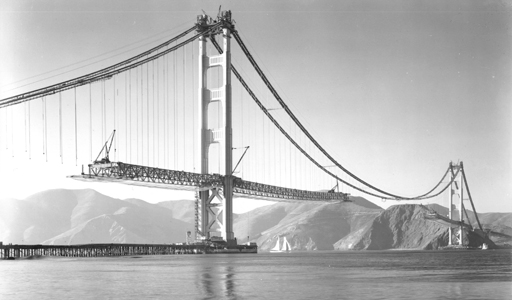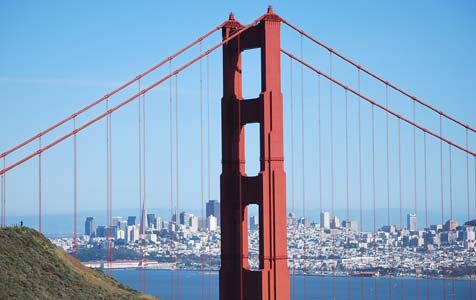On May 27, the Golden Gate Bridge will celebrate its 75th anniversary. The iconic structure—bathed in international orange—is a worldwide landmark that millions have admired over the years.

San Francisco residents were given a monumental display of modern engineering to marvel at while the Golden Gate Bridge was being constructed. It was on November 18, 1936, that the two sections of the main span were joined in the middle. Historic photo from the holdings of the Golden Gate Bridge, Highway and Transportation District, used with permission, www.goldengate.org.
Published: May, 2012
On May 27, the Golden Gate Bridge will celebrate its 75th anniversary. The iconic structure—bathed in international orange—is a worldwide landmark that millions have admired over the years. As the Bay Area prepares to honor the bridge’s history, Bay Crossings would like to take a moment to reflect on how bridging the Golden Gate affected the use of ferries in the North Bay.
The tradition of ferries crossing the San Francisco Bay dates all the way to 1850, when the first services operated between San Francisco and Oakland. Vessels that brought people during gold rush days were used for San Francisco-Sacramento and cross-bay service.
For Marin County, services began in 1868, when the Sausalito Land and Ferry Company purchased prime waterfront property in Sausalito, proceeding to lay out streets and divide the central waterfront into view lots. A small steamer known as The Princess was the first ferry to operate between Sausalito and San Francisco, a service largely run to promote real-estate development north of the Golden Gate Bridge. Rail lines that ran from the north to Sausalito also drew San Franciscans to venture into the northern counties.
In 1875, the North Pacific Coast Railroad purchased the ferry system in Marin. Then in 1907, it also acquired the railroad lines that served Marin County, and Sausalito became the hub of passenger transportation. In 1920, due to the unresponsiveness of the railroad to the demand for auto ferry passage, a new ferry company, the Golden Gate Ferry Co., was inaugurated and offered the first auto ferry service between Sausalito and San Francisco.
Prior to the opening of the Golden Gate Bridge, ferry and rail service flourished. When the bridge opened in May 1937, ferry operations between Marin and San Francisco declined, eventually ceasing entirely on February 28, 1941. For the next 29 years, driving across the bridge was the only way to travel directly between Marin and San Francisco. Over the course of the Golden Gate Bridge’s first year of operation, close to 3.3 million vehicles crossed the 1.7 mile span. By 1967, annual crossings had surpassed 28 million vehicles. The bridge was close to reaching the saturation point, and the public needed an alternative to the single-occupant automobile.
As a fixed, six-lane roadway, the Golden Gate Bridge could not be expanded to accommodate the continuing rise in traffic growth, so a number of studies were undertaken to identify alternate means of travel between Marin County and San Francisco. Numerous traffic management solutions were evaluated—from the building of a second bridge to Tiburon via Angel Island, to a possible underwater tunnel to link San Francisco and Marin, to lower-deck options for the Golden Gate Bridge.
The solution came in a very different form—the start of a public transit system that included buses and ferries. On November 10, 1969, Assembly Bill 584 authorized the Golden Gate Bridge and Highway District (GGBHD) to develop a transportation facility plan for implementing a mass transportation program in the U.S. Highway 101/Golden Gate corridor. This was to include any and all forms of transit, including ferry. At that time, the word "transportation" was added to the District’s name, and the mandate was clear: reduce traffic congestion on the bridge and the adjacent corridor to the north.
After extensive public outreach, including 21 public hearings in six counties, a unified system of buses and ferries emerged as the best means to serve the people of Marin and Sonoma counties. This public transit network is commonly known today as Golden Gate Transit (GGT) and Golden Gate Ferry (GGF).
On August 15, 1970, the very agency that had put the ferries out of business in 1941 took its first step into the transit business by inaugurating GGF service from Sausalito in southern Marin County to San Francisco. On the same day, GGT began running a limited bus service to and from the Sausalito Ferry Landing. GGT bus services from Sonoma and Marin counties to San Francisco began 16 months later in January 1972. On December 11, 1976, ferry service was expanded to include a second route operating between Larkspur and San Francisco.
Since the introduction of the buses and ferries, both systems have become an integral part of life in the North Bay counties of Marin and Sonoma. These services have been reshaped over the years to meet the changing needs of growing communities. And through its growth, GGT and GGF have continued to fulfill the mission of reducing automobile traffic and congestion while contributing to the protection of the environment with efficient, reliable and cost-effective alternatives to the private automobile. It is estimated that, without these services, motorists would experience more than a 30 percent increase in bridge traffic over the Golden Gate during the peak weekday morning commute hours. What’s more, these transit services keep 13,000 vehicles a day off the streets of San Francisco.
The Golden Gate Festival, the official public celebration of the 75th anniversary of the Golden Gate Bridge, will be a multi-faceted event held over Memorial Day weekend. The festivities will span the San Francisco waterfront from Fort Point (below the Golden Gate Bridge) to Pier 39.
Harkening back to the spirit of the Golden Gate Fiesta when the bridge opened on May 27, 1937, highlights of the 2012 celebration will include an historic watercraft parade, multiple music and dance stages, art installations, history and educational presentations, display of cars from 1937 to the present and bridge-related activities on Crissy Field and the Marina Green. These activities will be complemented by bridge-themed events and performances at waterfront venues including Fort Mason Center, Ghirardelli Square, San Francisco Maritime National Historical Park, Fisherman’s Wharf, and Pier 39, among others. On Sunday evening at approximately 9:30 p.m., the weekend celebration will conclude with a spectacular 75th anniversary fireworks display and grand finale.
While the bridge will be open to auto traffic only and there will be no bridge walk, there will be numerous vantage points and ways for the public to share in the festival experience. A full listing of events planned for the celebration can be found at www.goldengatebridge75.org.

Photo by Joel Williams

Golden Gate Ferry service has provided a reliable and cost-effective alternative to the Golden Gate Bridge since 1970. Photo by Joel Williams

